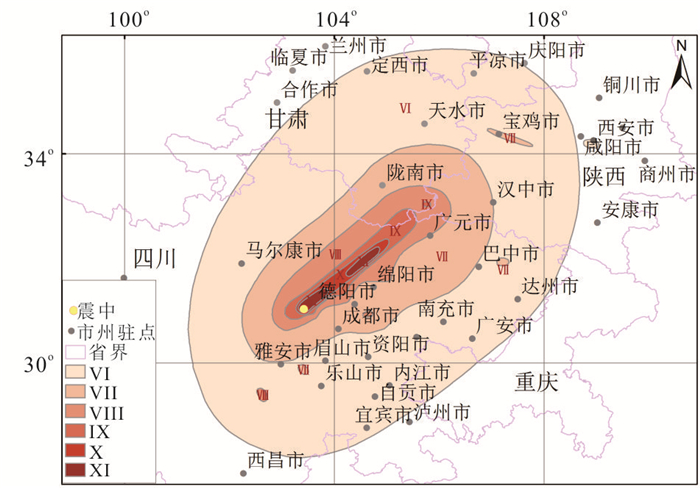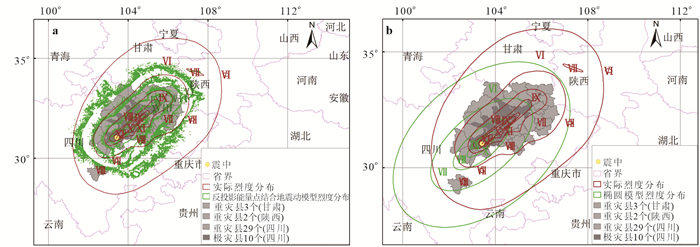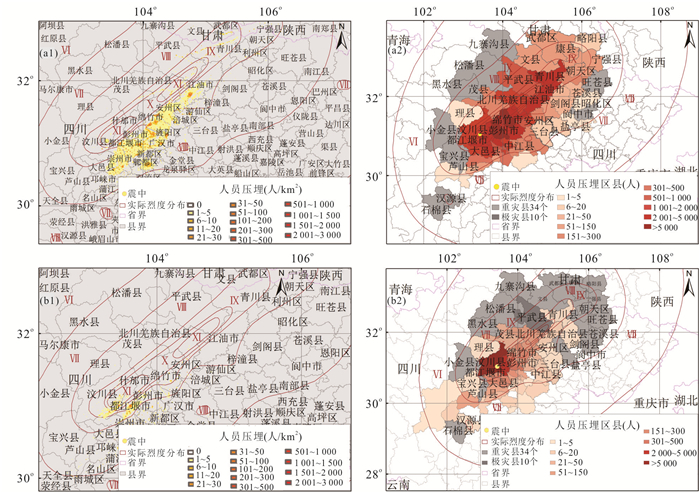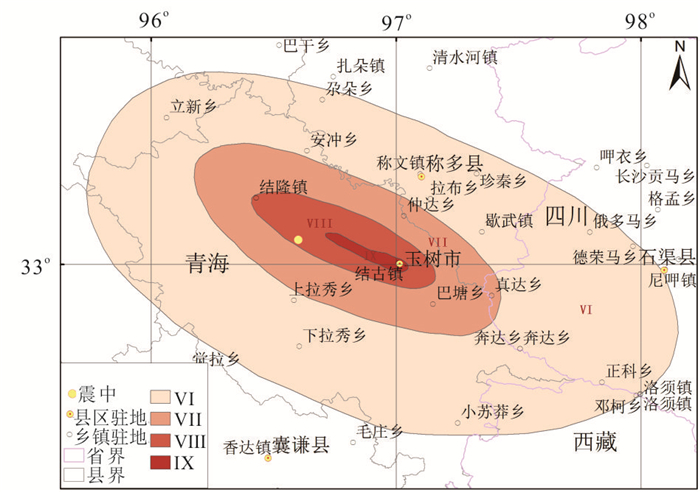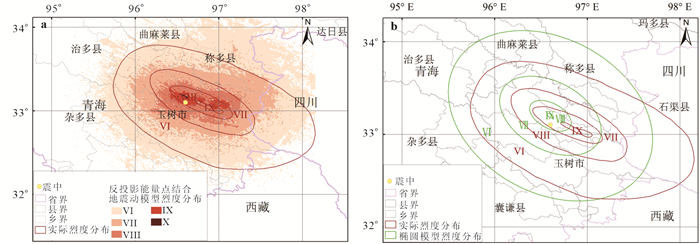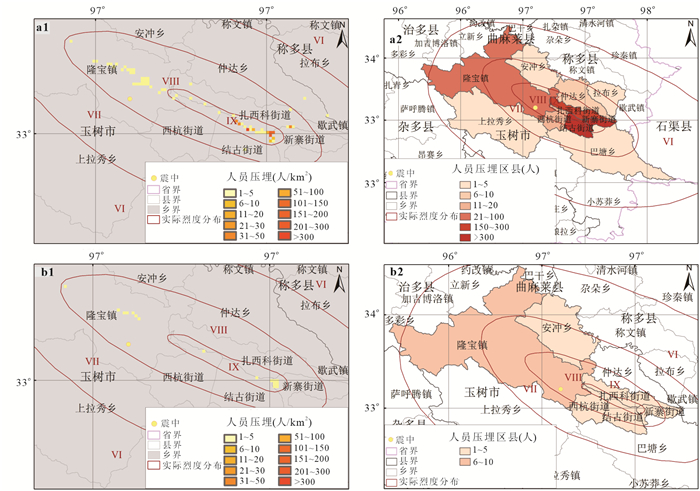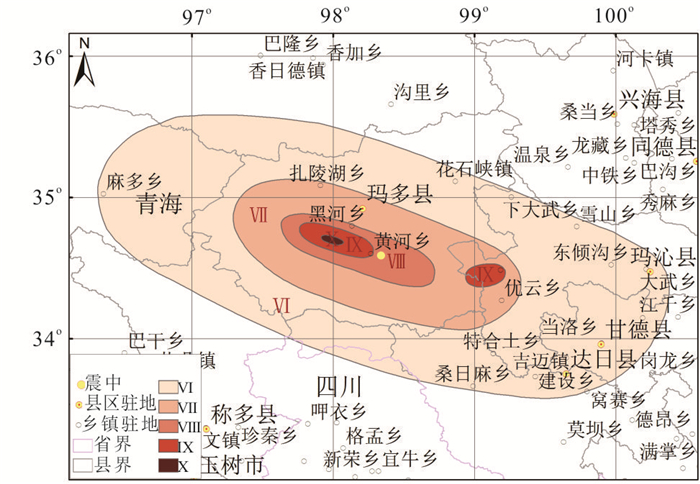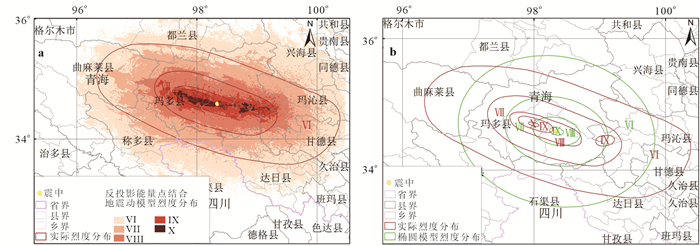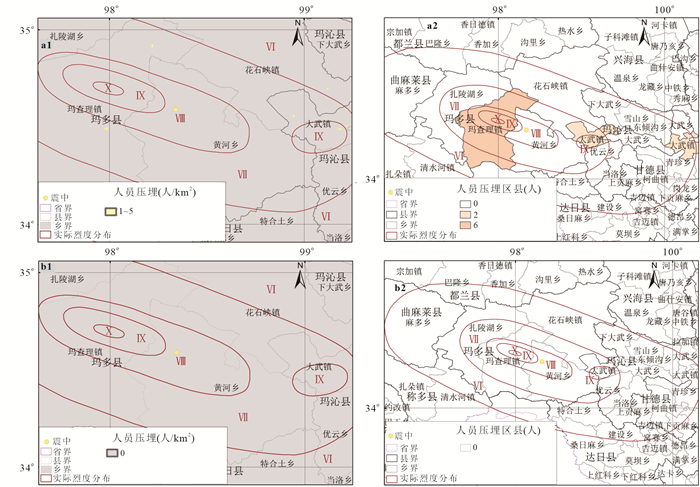Evaluation of Post⁃Earthquake Buried Personnel Based on a New Model of Seismic Intensity Rapid Assessment
-
摘要: 破坏性地震发生后,对震后压埋人员进行有效估计,是科学、有序应急处置和救援的基础. 地震烈度快速评估结果是震后人员压埋估计中不可或缺的一类基础数据,对人员压埋数量及分布估计的合理性、准确性有重要作用. 以一种新型的基于反投影能量点结合断层最短距离地震动衰减方法、以及目前使用最为广泛的传统椭圆衰减模型方法的烈度快速评估结果为基础,对甘肃及周边近年来发生的3次7级以上地震进行震后人员压埋进行估计,并与实际灾情进行对比. 相较于传统椭圆地震烈度衰减模型烈度快速评估方法,基于反投影能量点结合地震动参数衰减模型的烈度快速评估能更为准确、精细地确定地震重灾区、极重灾区的分布;对震后人员压埋总数、压埋重点区域判定的合理性和准确度改进效果明显,该新型烈度快速评估方法在7级以上破坏性大地震人员压埋估计中显示了良好的适用性,在评估时效上也可满足地震应急指挥决策、应急救援工作的实际需求.Abstract: Effective estimation of buried personnel after earthquake is the basis for scientific and orderly emergency response and rescue.Seismic intensity, an imperative data for rapid assessment of post⁃earthquake personnel buried, plays a crucial role in ensuring the reasonability and accuracy of evaluation results. With the help of intensity calculation results generated in a ground motion attenuation model based on back⁃projection energy point & shortest distance of earthquake fault, as well as the most widely used elliptical attenuation model at present, this paper firstly carries out a rapid evaluation of buried personnel in three earthquakes with a magnitude of seven or above occurred nearby Gansu province in recent years and subsequently performs a comparison with the actual situation. Compared with the elliptical attenuation model of earthquake intensity, the intensity calculation results based on the back⁃projection energy point & seismic parameter attenuation model are more capable of determining the distribution of severely afflicted areas and extremely severely afflicted areas accurately and finely, and perfecting the reasonability and accuracy of the total number of personnel buried and classification of key buried areas. The back⁃projection energy point & seismic parameter attenuation modelhas proved itself with excellent applicability in the rapid evaluation of buried personnel in destructive earthquakes with a magnitude of seven or above, and with fine timeliness to meet the actual needs of earthquake emergency response and emergency rescue.
-
表 1 行政区域人口密度及调整系数
Table 1. Population density and adjustment coefficient
行政区域级别 ρIj(人/km2) λj1 λj2 城市
乡镇
农村300
200
801.22
1.10
1.10-0.34
0.70
0.70表 2 发震时间修正系数
Table 2. Correction coefficient of earthquake time
烈度 Ⅵ Ⅶ Ⅷ Ⅸ Ⅹ Ⅺ Ⅻ 夜晚/白天 17.8/1 8.2/1 4.3/1 2.4/1 1.5/1 1.4/1 1.7/1 表 3 基于方法A烈度评估下汶川8.0级地震甘肃灾区Ⅶ(7)度区以上人口分布
Table 3. The population distribution ofWenchuan 8.0 earthquakedisaster area(≥Ⅶ)in Gansu province based results of model A
烈度区 总人口(人)
城市/乡镇/农村栅格数量(个)
城市/乡镇/农村Ⅸ(9) 0/20 988 /107 439 0/25/1 775 Ⅷ(8) 26 770/34 992/268 500 113/130/6 942 Ⅶ(7) 86 000/52 501/510 914 850/323/12 573 表 4 四川汶川8.0级地震人员死亡失踪统计表
Table 4. Statistics of death and missing persons in Wenchuan M8.0 earthquake
区域 死亡人数(人) 失踪人数(人) 四川省 68 475 17 925 甘肃省 365 11 陕西省 122 0 重庆市 16 0 河南省 2 0 云南省 1 0 湖北省 1 0 贵州省 1 0 湖南省 1 0 极重灾区 四川10县区:汶川县、都江堰市、彭州市、什邡市、安县(安州区)、北川县、平武县、青川县、茂县、绵竹市 67 038 17 645 重灾区 四川29县区:大邑县、崇州市、旌阳区、罗江区、中江县、广汉市、涪城区、游仙区、三台县、盐亭县、梓潼县、江油市、利州区、元坝县(昭化区)、朝天区、旺苍县、剑阁县、苍溪县、阆中市、汉源县、石棉县、芦山县、宝兴县、理县、松潘县、九寨沟县、小金县、黑水县 1 149 132 甘肃3县区:武都区、文县、康县 264 11 陕西2县区:宁强县、略阳县 47 0 表 5 四川汶川8.0级震后人员压埋评估结果
Table 5. Rapid assessment results of personnel buried in Wenchuan M8.0 earthquake
区域 实际压埋(人) 快速评估结果(人) 基于椭圆衰减模型烈度区 基于最短断层距地震动衰减模型烈度区 四川省 86 400 13 206 65 745 甘肃省 376 0 311 陕西省 122 0 117 其中 极重灾区10县区 84 683 11 770 44 615 重灾区34县区 1 603 624 19 826 其他区域 114 812 1732 注:实际压埋人数为地震中死亡与失踪人数之和. 表 6 青海玉树7.1级震后人员压埋评估结果
Table 6. Rapid assessment results of personnel buried inYushu M7.1 earthquake
区域 实际压埋(人) 快速评估结果(人) 基于椭圆衰减模型烈度区 基于最短断层距地震动衰减模型烈度区 青海省 2 968 18 1 417 其中 极重灾区:结古镇(结古街道、西杭街道、扎西科街道、新寨街道) 2 155 8 1 296 重灾区及其他 813 10 121 有人员压埋乡镇、街道 结古街道 1 566 新寨街道 3 549 扎西科街道 1 168 西杭街道 3 13 隆宝镇 7 101 仲达乡 0 10 拉布乡 0 3 上拉秀乡 0 2 巴塘乡 0 2 安冲乡 1 1 注:1. 实际压埋指死亡与失踪人数之和;2. 结古街道、新寨街道、扎西科街道、西杭街道2010年时为结古镇所辖. 表 7 青海玛多7.4级震后人员压埋评估结果
Table 7. Rapid assessment results of personnel buried in Maduo M7.4 earthquake
区域 实际压埋(人) 快速评估结果(人) 基于椭圆衰减模型烈度区 基于最短断层距地震动衰减模型烈度区 青海省 0 0 8 其中 极重灾区:玛理查镇、大武镇 0 0 8 重灾区:黄河乡 0 0 0 有人员压埋乡镇、街道 玛查理镇 0 0 6 大武镇 0 0 2 优云乡 0 0 0 大武乡 0 0 0 花石峡镇 0 0 0 黄河乡 0 0 0 -
Bai, X. F., Nie, G. Z., Dai, Y. Q., et al., 2021. Modeling and Testing Earthquake⁃Induced Landslide Casualty Rate Based on a Grid in a Kilometer Scale: Taking the 2014 Yunnan Ludian Ms6.5 Earthquake as a Case. Journal of Seismological Research, 44(1): 87-95 (in Chinese with English abstract). Chen, W. K., Wang, D., Zhang, C., et al., 2022a. Estimating Seismic Intensity Maps of the 2021 Mw 7.3 Madoi, Qinghai and Mw 6.1 Yangbi, Yunnan, China Earthquakes. Journal of Earth Science, 33(4): 839-846. https://doi.org/10.1007/s12583⁃021⁃1586⁃9 Chen, W. K., Wang, D., Si, H. J., et al., 2022b. Rapid Estimation of Seismic Intensities Using a New Algorithm that Incorporates Array Technologies and Ground⁃Motion Prediction Equations (GMPEs). Bulletin of the Seismological Society of America, 112(3): 1647-1661. https://doi.org/10.1785/0120210207 Chen, W. K., Rao, G., Kang, D. J., et al., 2023. Early Report of the Source Characteristics, Ground Motions, and Casualty Estimates of the 2023 Mw 7.8 and 7.5 Turkey Earthquakes. Journal of Earth Science, 34(2): 297-303. https://doi.org/10.1007/s12583⁃023⁃1316⁃6 Cui, J. W., Lu, D. W., Gao, D., et al., 2008. Intensity Zoning for Earthquake Area Based on Synthesized Ground Motions. Journal of Seismological Research, 31(4): 388-393 (in Chinese with English abstract). Chen, H. F., Dai, J. W., Sun, B. T., et al., 2011. Investigation Report on Influence Factors of Casualties in April 14, 2010 Yushu Earthquake. Earthquake Engineering and Engineering Dynamics, 31(4): 18-25(in Chinese with English abstract). Dreger, D., Kaverina, A., 2000. Seismic Remote Sensing for the Earthquake Source Process and Near⁃Source Strong Shaking: A Case Study of the October 16, 1999 Hector Mine Earthquake. Geophysical Research Letters, 27(13): 1941-1944. doi: 10.1029/1999GL011245 Ding, B. R., Sun, J. J., Li, X. D., et al., 2014. Research Progress and Discussion of the Correlation Between Seismic Intensity and Ground Motion Parameters. Engineering and Engineering Dynamics, 34(5): 7-20. (in Chinese with English abstract). Ding, B. R., Sun, J. J., Du, K., et al., 2017. Study on Relationship Between Seismic Intensity and Peak Ground Acceleration, Peak Ground Velocity. Engineering and Engineering Dynamics, 37(2): 26-36(in Chinese with English abstract). GB/T 17742-2020, 2020. The Chinese Seismic Intensity Scale. China Standard IndustryPress, Beijing(in Chinese) Gu, G. L., An, L. Q., Zhu, H., et al., 2021. Assessment of Seismic Buried Personnel in Urban Area: a Case Study of Tianjin Urban Area. China Earthquake Engineering Journal, 46(6): 1352-1360 (in Chinese with English abstract). Ishii, M., Shearer, P., Houston, H., et al., 2005. Extent, Duration and Dpeed of the 2004 Sumatra⁃Andaman Earthquake Imaged by the Hi⁃Net Array. Nature, 435(7044): 933-936. https://doi.org/10.1038/nature03675 Li, H. H., 1987. Preliminary Analysis on the Highest Rate of Casualty in Earthquake Disasters. Journal of Catastrophology, (2): 41-47. (in Chinese with English abstract). Meng, L. Y., Shi, B. P., 2011. Near⁃Fault Strong Ground Motion Simulation of the May 12, 2008, Mw7.9 Wenchuan Earthquake by Dynamical Composite Source Model. Chinese Journal of Geophysics, 54(4): 1010-1027 (in Chinese with English abstract). Rhie, J., Dreger, D. S., Murray, M., et al., 2009. Peak Ground Velocity Shake Maps Derived from Geodetic Slip Models. Geophysical Journal International, 179(2): 1105-1112. https://doi.org/10.1111/j.1365⁃246X.2009.04327.x Ren, J., Xu, Z. S., Duan, Y. H., et al., 2020. Identification of Earthquake Intensity Attenuation Relationship modelsin Various Provinces of China. Seismological and Geomagnetic Observation and Research, 41(3): 75-82 (in Chinese with English abstract). Smith, E. M., Mooney, W. D., 2021. A Seismic Intensity Survey of the 16 April 2016 Mw 7.8 Pedernales, Ecuador, Earthquake: A Comparison with Strong⁃Motion Data and TeleseismicBackprojection. Seismological Research Letters, 92(4): 2156-2171. https://doi.org/10.1785/0220200290 Si, H. J., Midorikawa, S., 1999. New Attenuation Relationships for Peak Ground Acceleration and Velocity Considering Effects of Fault Type and Site Condition. Collected Papers from the Department of Construction of the Japanese Architectural Society, 64(523): 63-70. https://doi.org/10.3130/aijs.64.63_2 Wu, B., Li, Z. Q., Qi, W. H., et al., 2017. Trapped Population Distribution in Earthquake and Rescue Policy Based on Township Residential Area Scale: a Case Study of Urumqi Area. North China Earthquake Sciences, 35(3): 13-19 (in Chinese with English abstract). Wu, C., Yin, H. T., Sun, Q. W., et al., 2011. Study on the Feasibility of the Search and Rescue Information System Based on ArcGIS. Plateau Earthquake Research, 23(2): 54-59 (in Chinese with English abstract). Wang, D., Takeuchi, N., Kawakatsu, H., et al., 2016. Estimating High Frequency Energy Radiation of Large Earthquakes by Image Deconvolution Back⁃Projection. Earth and Planetary Science Letters, 449: 155-163. https://doi.org/10.1016/j.epsl.2016.05.051 Wang, D. C., Ni, S. D., Li, J., 2013. Resarch Status of Rapid Assessment on Seismic Intensity. Progress in Geophysics, 28(4): 1772-1784 (in Chinese with English abstract). Wang, H. Y., 2010. Prediction of Acceleration Field of the 14 April 2010 Yushu Earthquake. Chinese Journal of Geophysics, 53(10): 2345-2354 (in Chinese with English abstract). Xu, J. D., Wei, F. Q., Zhang, L. Q., et al., 2008. Preliminary Study on Evaluating the Number of Casualities and Trapped Victims by a Earthquake: A Case Study of Zhangzhou City, Fujian Province. Journal of Seismological Research, 31(4): 382-387, 413 (in Chinese with English abstract). Xiao, D. S., Hang, D. F., Chen, W. F., et al., 2009. Prediction Model for Buried Personnel Probability in Earthquake. Journal of Southwest Jiaotong University, 44(4): 574-579 (in Chinese with English abstract). Xu, L. H., 2016. Study on the Rapid Evaluation of Earthquake Casualties(Dissertation). Institute of Disaster Prevention, Beijing(in Chinese with English abstract). Yao, H., Shearer, P. M., Gerstoft, P., 2012. Subevent Location and Rupture Imaging Using Iterative Backprojection for the 2011 Tohoku Mw 9.0 Earthquake. Geophysical Journal International, 190(2): 1152-1168. https://doi.org/10.1111/j.1365⁃246X.2012.05541.x Yang, M. R., 2014. Study on the Assessment Method of Buried Personnel Distribution in Earthquake(Dissertation). Institute of Engineering Mechanics, China Earthquake Administration, Harbin(in Chinese with English abstract). Yu, S. Z., Zhang, L. X., Yang, M. R., 2015. Assessment of Buried People Distribution after Earthquake. Earthquake Engineering and Engineering Dynamics, 35(2): 138-143. (in Chinese with English abstract). Yin, X., Li, X., Ma, Z., et al., 2021. Characteristics of Seismic Disasters Caused by the Maduo MS7.4 Earthquake in Qinghai Province. China Earthquake Engineering Journal, 43(4): 868-875. (in Chinese with English abstract). Zhou, Z. H., Chen, W. K., He, S. L., et al., 2019. Application and Evaluation on a Evaluating Method for Distribution of Earthquake Buried Personnel Based on Population Kilometers Grid: Taking Minxian⁃Zhangxian M6.6 Earthquake as an Example. Journal of Seismological Research, 42(2): 288-294+306 (in Chinese with English abstract). 白仙富, 聂高众, 戴雨芡, 等, 2021. 基于公里格网单元的地震滑坡人员死亡率评估模型——以2014年鲁甸Ms6.5地震为例. 地震研究, 44(1): 87-95. https://www.cnki.com.cn/Article/CJFDTOTAL-DZYJ202101012.htm 崔建文, 卢大伟, 高东, 等, 2008. 基于合成地震动的震区烈度划分. 地震研究, 31(4): 388-393. https://www.cnki.com.cn/Article/CJFDTOTAL-DZYJ200804015.htm 陈洪富, 戴君武, 孙柏涛, 等, 2011. 玉树7.1级地震人员伤亡影响因素调查与初步分析. 地震工程与工程振动, 31(4): 18-25. https://www.cnki.com.cn/Article/CJFDTOTAL-DGGC201104003.htm 丁宝荣, 孙景江, 李小东, 等, 2014. 地震烈度和地震动参数相关性研究进展及讨论. 地震工程与工程振动, 34(5): 7-20. https://www.cnki.com.cn/Article/CJFDTOTAL-DGGC201405002.htm 丁宝荣, 孙景江, 杜轲, 等, 2017. 地震烈度与峰值加速度、峰值速度相关性研究. 地震工程与工程振动, 37(2): 26-36. https://www.cnki.com.cn/Article/CJFDTOTAL-DGGC201702004.htm GB/T 17742⁃2020, 2020. 中国地震烈度表. 北京: 中国标准工业出版社. 谷国梁, 安立强, 朱宏, 等, 2021. 城市地震压埋人员分布评估研究——以天津市区为例. 地震工程学报, 46(6): 1352-1360. https://www.cnki.com.cn/Article/CJFDTOTAL-ZBDZ202106013.htm 李海华, 1987. 震灾最大伤亡率的初步分析. 灾害学, (2): 41-47. https://www.cnki.com.cn/Article/CJFDTOTAL-ZHXU198702006.htm 孟令媛, 史保平, 2011. 应用动态复合震源模型模拟汶川M_w 7.9地震强地面运动. 地球物理学报, 54(4): 1010-1027. https://www.cnki.com.cn/Article/CJFDTOTAL-DQWX202402010.htm 任静, 徐志双, 段乙好, 等, 2020. 中国各省区地震烈度衰减关系模型甄别. 地震地磁观测与研究, 41(3): 75-82. https://www.cnki.com.cn/Article/CJFDTOTAL-DZGJ202003010.htm 吴兵, 李志强, 齐文华, 等, 2017. 以乡镇居民地为单元的震后埋压人员分布与救援对策——以乌鲁木齐市为例. 华北地震科学, 35(3): 13-19. https://www.cnki.com.cn/Article/CJFDTOTAL-HDKD201703003.htm 吴晨, 殷海涛, 孙庆文, 等, 2011. 基于ArcGIS的地震搜救信息系统可行性研究. 高原地震, 23(2): 54-59. https://www.cnki.com.cn/Article/CJFDTOTAL-GYDZ201102012.htm 王德才, 倪四道, 李俊, 2013. 地震烈度快速评估研究现状与分析. 地球物理学进展, 28(4): 1772-1784. https://www.cnki.com.cn/Article/CJFDTOTAL-DQWJ201304020.htm 王海云, 2010. 2010年4月14日玉树M_s7.1地震加速度场预测. 地球物理学报, 53(10): 2345-2354. https://www.cnki.com.cn/Article/CJFDTOTAL-DQWX201010010.htm 许建东, 危福泉, 张来泉, 等, 2008. 地震人员伤亡与压埋人员评估方法的初步研究——以福建省漳州市区为例. 地震研究, 31(4): 382-387, 413. https://www.cnki.com.cn/Article/CJFDTOTAL-DZYJ200804014.htm 肖东升, 黄丁发, 陈维锋, 等, 2009. 地震压埋人员压埋率预估模型. 西南交通大学学报, 44(4): 574-579. https://www.cnki.com.cn/Article/CJFDTOTAL-XNJT200904017.htm 许立红, 2016. 基于快速评估的地震人员伤亡研究(硕士学位论文). 北京: 防灾科技学院. 杨明儒, 2014. 地震压埋人员分布评估方法研究(硕士学位论文). 哈尔滨: 中国地震局工程力学研究所. 余世舟, 张令心, 杨明儒, 2015. 地震压埋人员分布评估方法初探. 地震工程与工程振动, 35(2): 138-143. https://www.cnki.com.cn/Article/CJFDTOTAL-DGGC201502016.htm 殷翔, 李鑫, 马震, 等, 2021. 青海玛多Ms7.4地震震害特点分析. 地震工程学报, 43(4): 868-875. https://www.cnki.com.cn/Article/CJFDTOTAL-ZBDZ202104016.htm 周中红, 陈文凯, 何少林, 等, 2019. 基于人口公里格网的地震压埋人员分布评估方法的应用与评价——以甘肃岷县漳县6.6级地震为例. 地震研究, 42(2): 288-294+306. https://www.cnki.com.cn/Article/CJFDTOTAL-DZYJ201902018.htm -









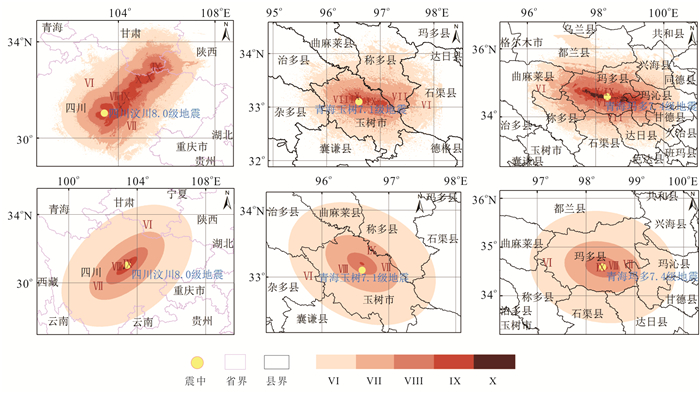
 下载:
下载:

